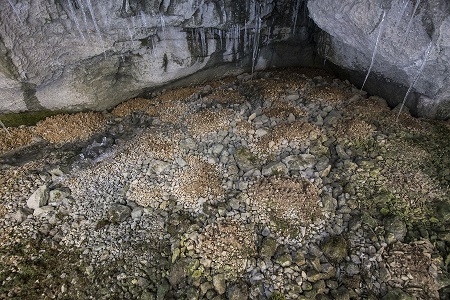Understanding cryoturbation – using karst caves to improve predictions of soil carbon fate upon thawing permafrost (CryoKarst)
Principal Investigator at ZRC SAZU
Jaroslav Obu, PhD-
Original Title
Razumeti krioturbacijo – do boljših napovedi usode ogljika iz talečega permafrosta s pomočjo kraških jam (CryoKarst)
Project Team
Matej Blatnik, PhD, Franci Gabrovšek, PhD-
ARIS Project ID
J6-4634
-
Duration
1 December 2022–30 November 2025 -
Lead Partner
Research Centre of the Slovenian Academy of Sciences and Arts
-
Financial Source
Slovenian Research Agency

Partners
Alfred Wegener Institute, Geodetic institute of Slovenia, University of Oslo, Hamburg University, Univerza v Stockholmu, Stockholm University
Climate change due to increased concentrations of greenhouse gasses presents one of the main challenges that humanity faces today. Rapid permafrost thawing in the Arctic might substantially increase these emissions by decomposition of thawed organic matter stored in the ground for centuries. One of the key processes governing the Arctic carbon cycle are internal soil movements under freezing conditions (cryoturbation). The process itself and its mechanisms related to it are poorly understood due to several observation challenges. This is a critical limitation for implementation of cryoturbation into the Earth System Models (ESMs), which hinders accurate quantifications of CO2 emissions and methane from thawing permafrost.
The project will overcome these limitations by laboratory cryoturbation experiments and observing ground movements using automated time-lapse photogrammetry in karst caves, which are unique environments for cryoturbation induced ground movement monitoring. Several patterned ground sites with both present and absent permafrost will be instrumented with time-lapse camera systems, together with temperature and moisture sensors, and analysed for ground properties. We will make use of the recent advances in the photogrammetric structure from motion technique to monitor ground surface movements in 3D on hourly basis and relate the ground movements to environmental variables. This will consequently reveal new insights into critical ground movement processes governing cryoturbation.
The obtained data will be used to develop an empirical cryoturbation model, which will facilitate cryoturbation implementation in Earth System Models and will significantly reduce uncertainties in the greenhouse gas emissions estimates due to thawing permafrost. Moreover, the time-lapse photogrammetry presents a novel approach in patterned ground studies, which may push the current knowledge boundaries in this field substantially and have impacts far beyond the project’s objectives. The project will also provide a unique insight into periglacial phenomena in Slovenian karst caves unveiling their ecosystem, educational and tourist potentials.
